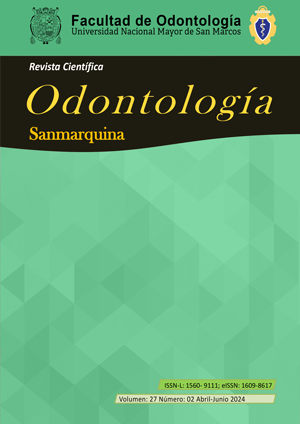Mesialization of the posterior sector due to the absence of the first molar through the use of micro-implants
DOI:
https://doi.org/10.15381/os.v27i2.27301Keywords:
Molar mesialization, dental absence, microimplantsAbstract
A clinical case of a 16-year-old female patient is presented, who reported having lost her upper left first molar due to caries two years ago is presented. She is a patient with class II skeletal, mesofacial malocclusion, straight profile, class I right molar, absence of tooth 26, class I right canine and tendency to class II left canine, with mild upper and lower crowding and lower dental midline deviated to the left. It was treated through the use of a microimplant, with the objective of mesializing teeth 27 and 28 as well as improving the settlement of the left canine class. The mesialization of the upper left posterior teeth was successfully completed, establishing adequate occlusion, eliminating crowding, achieving good anterior guidance with coincident dental midlines, providing a functional and harmonious smile. The purpose of this case is to demonstrate that with the appropriate tools and mechanics in addition to good planning, control of the anchorage in the posterior closing movement can be achieved in the absence of an absent molar, and thus achieve adequate occlusion.
Downloads
References
Hatami A, Dreyer C. The extraction of first, second or third permanent molar teeth and its effect on the dentofacial complex. Aust Dent J. 2019;64(4):302-311. DOI: https://doi.org/10.1111/adj.12716
Demir P, Aydoğdu H. Ideal spontaneous space closure after late extraction of permanent first molar teeth. Cumhuriyet Dent J. 2020;23(4):331–9. DOI: https://doi.org/10.7126/cumudj.793013
Ratanasereeprasert N, Weng CY, Yang SYH, Chen YJ, Yao CCJ. Molar space closure: To do or not to do?. APOS Trends Orthod 2022;12:61-8. DOI: https://doi.org/10.25259/APOS_112_2021
Cardoso PC, Mecenas P, Normando D. The impact of the loss of first permanent molars on the duration of treatment in patients treated with orthodontic space closure and without skeletal anchorage. Prog Orthod. 2022;23(1):32. DOI: https://doi.org/10.1186/s40510-022-00427-2
Thiesen G, Gribel BF, Pereira KC, Freitas MP. Is there an association between skeletal asymmetry and tooth absence? Dental Press J Orthod. 2016;21(4):73-79. DOI: https://doi.org/10.1590/2177-6709.21.4.073-079.oar
Schubert A, Jäger F, Maltha JC, Bartzela TN. Age effect on orthodontic tooth movement rate and the composition of gingival crevicular fluid. J Orofac Orthop. 2020;81(2):113-25. DOI: https://doi.org/10.1007/s00056-019-00206-5
Baik UB. Molar protraction: Orthodontic substitution of missing posterior teeth. In: Kim KB, editor. Temporary Skeletal Anchorage Devices: A Guide to Design and Evidence-Based Solution. Berlin, Heidelberg: Springer; 2014. p. 119-60. DOI: https://doi.org/10.1007/978-3-642-55052-2_8
Baik UB, Sugawara J, Chun YS, Mandair S, Park JH. Envisioning post-treatment occlusions after space closure using temporary skeletal anchorage devices. J Clin Pediatr Dent. 2019;43(2):131–6. DOI: https://doi.org/10.17796/1053-4625-43.2.11
Baik UB, Chun YS, Jung MH, Sugawara J. Protraction of mandibular second and third molars into missing rst molar spaces for a patient with an anterior open bite and anterior spacing. Am J Orthod Dentofacial Orthop. Am J Orthod Dentofacial Orthop. 2012;141(6):783-795. DOI: https://doi.org/10.1016/j.ajodo.2010.07.031
Naoum S, Allan Z, Yeap CK, Razza JM, Murray K, Turlach B, et al.Trends in orthodontic management strategies for patients with congenitally missing lateral incisors and premolars. Angle Orthod. 2021;91(4):477-483. DOI: https://doi.org/10.2319/092320-809.1
Palone M, Casella S, de Sbrocchi A, Siciliani G, Lombardo L. Space closure by miniscrew-assisted mesialization of an upper third molar and partial vestibular fixed appliance: A case report. Int Orthod. 2022;20(1):106002. DOI: https://doi.org/10.1016/j.ortho.2021.100602
Johns G. Orthodontics mini implants – A brief review. Int Dent J Stud Res. 2021;9(4):176–180. DOI: https://doi.org/10.18231/j.idjsr.2021.033
Negi N, Sharma D, Chandel M, Jhingta P. Microimplant assisted extraction space closure: Biomechanical considerations. J Dent Implants. 2015;5(1):87-89. DOI: https://doi.org/10.4103/0974-6781.154457
Marusamy KO, Ramasamy S, Wali O. Molar protraction using miniscrews (temporary anchorage device) with simultaneous correction of lateral crossbite: An orthodontic case report. J Int Soc Prev Community Dent. 2018;8(3):271–276. DOI: https://doi.org/10.4103/jispcd.JISPCD_447_17
Bhagat A, Goel M, Batra P, Chugh RK. Mandibular molar protraction with orthodontic temporary anchorage devices: A case report. Indian J Clin Pract. 2014;25(4):338-341.
Nagaraj K, Upadhyay M, Yadav S. Titanium screw anchorage for protraction of mandibular second molars into first molar extraction sites. Am J Orthod Dentofacial Orthop. 2008;134(4):583-591. DOI: https://doi.org/10.1016/j.ajodo.2006.09.055
Roberts WE, Nelson CL, Goodacre CJ. Rigid implant anchorage to close a mandibular First molar extraction site. J Clin Orthod. 1994;28(2):693-704
Teo T, Ashley P, Parekh S, Noar J. The evaluation of spontaneous space closure after the extraction of first permanent molars. Eur Arch Paediatr Dent. 2013;14(4):207–212. DOI: https://doi.org/10.1007/s40368-013-0042-7
Baik UB, Kook YA, Bayome M, Park JU, Park JH. Vertical eruption patterns of impacted mandibular third molars after the mesialization of second molars using miniscrews. Angle Orthod. 2016;86(4):565-570. DOI: https://doi.org/10.2319/061415-399.1
Downloads
Published
Issue
Section
License
Copyright (c) 2024 Matilde Valeria Pérez-Landeros, Cesar Fernando Gonzalez-Ochoa, Jacqueline Adelina Rodríguez-Chávez, José Luis Meléndez-Ruiz, Celia Guerrero-Velázquez

This work is licensed under a Creative Commons Attribution 4.0 International License.
AUTHORS RETAIN THEIR RIGHTS:
a. Authors retain their trade mark rights and patent, and also on any process or procedure described in the article.
b. Authors retain their right to share, copy, distribute, perform and publicly communicate their article (eg, to place their article in an institutional repository or publish it in a book), with an acknowledgment of its initial publication in the Odontología Sanmarquina.
c. Authors retain theirs right to make a subsequent publication of their work, to use the article or any part thereof (eg a compilation of his papers, lecture notes, thesis, or a book), always indicating the source of publication (the originator of the work, journal, volume, number and date).




















